
This is a test of the OER Commons system for WCS in Williamson County, TN

This is a test of the OER Commons system for WCS in Williamson County, TN
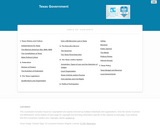
A textbook written by Dr. Daniel Regalado (Professor of Government and History at Odessa College), along with some sources from OpenStax material, for GOVT 2306: Texas Government. Source was written in Fall 2017.

Texas Government OER textbook. Written by Dr. Daniel M. Regalado. Originally written in Fall 2017, reformatted May 2022. This EBook is the first OER Texas Government textbook ever written in the United States.

Texas Government OER textbook. Written by Dr. Daniel M. Regalado. Originally written in Fall 2017, reformatted May 2022. This EBook is the first OER Texas Government textbook ever written in the United States. Unless otherwise noted, this textbook, written by Dr. Daniel M. Regalado, is CC BY 2.0 license. The textbook content was produced by Dr. Daniel M. Regalado and is licensed under a Creative Commons Attribution 2.0 license, except for the following changes and additions, which are (CC BY 2.0 license) 2023 by Daniel Brown and are licensed under a Creative Commons Attribution 2.0 license.

Texas Government OER textbook. Written by Dr. Daniel M. Regalado. Originally written in Fall 2017, reformatted May 2022. This EBook is the first OER Texas Government textbook ever written in the United States. Unless otherwise noted, this textbook, written by Dr. Daniel M. Regalado, is CC BY 2.0 license. The textbook content was produced by Dr. Daniel M. Regalado and is licensed under a Creative Commons Attribution 2.0 license, except for the following changes and additions, which are (CC BY 2.0 license) 2023 by Daniel Brown and are licensed under a Creative Commons Attribution 2.0 license.
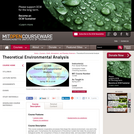
This course analyzes cooperative processes that shape the natural environment, now and in the geologic past. It emphasizes the development of theoretical models that relate the physical and biological worlds, the comparison of theory to observational data, and associated mathematical methods.

This resource is useful in a first-year composition course. The examples are intended for a literature-based composition class. There are also examples of opening strategies intended for an expository composition class. The Word version will give both types of examples.
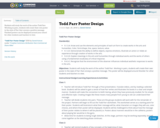
Students will study the work of the author Todd Parr. Working in pairs, students will create their own poster in the style of Parr that conveys a positive message. Finished posters can be displayed around your school for other students and teachers to view.
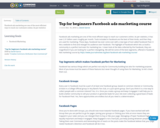
Facebook ads marketing are one of the most efficient ways to reach our customers online. As per statistics

The goal of these lectures is to provide an introduction to Fourier analysis. The first topic is Fourier series, in particular, the Gibbs phenomenon and the dependence of their convergence properties on the suitability method used. The second topic is the Fourier transform, first the L¹ theory and then, using Hermite functions, the L² theory. The third topic is L. Schwartz’s theory of tempered distributions. The fourth topic is the theory of weak convergence of probability measures and application to a derivation of the Lévy-Khinchine formula for the Fourier transform of infinitely divisible probability measures. The final topic is the elementary theory of singular integral operators, starting with the Hilbert transform and then using the method of rations to prove the Lᵖ boundedness of even Calderòn-Zygmund kernels.
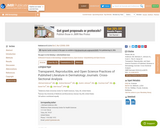
Background: Reproducible research is a foundational component for scientific advancements, yet little is known regarding the extent of reproducible research within the dermatology literature. Objective: This study aimed to determine the quality and transparency of the literature in dermatology journals by evaluating for the presence of 8 indicators of reproducible and transparent research practices. Methods: By implementing a cross-sectional study design, we conducted an advanced search of publications in dermatology journals from the National Library of Medicine catalog. Our search included articles published between January 1, 2014, and December 31, 2018. After generating a list of eligible dermatology publications, we then searched for full text PDF versions by using Open Access Button, Google Scholar, and PubMed. Publications were analyzed for 8 indicators of reproducibility and transparency—availability of materials, data, analysis scripts, protocol, preregistration, conflict of interest statement, funding statement, and open access—using a pilot-tested Google Form. Results: After exclusion, 127 studies with empirical data were included in our analysis. Certain indicators were more poorly reported than others. We found that most publications (113, 88.9%) did not provide unmodified, raw data used to make computations, 124 (97.6%) failed to make the complete protocol available, and 126 (99.2%) did not include step-by-step analysis scripts. Conclusions: Our sample of studies published in dermatology journals do not appear to include sufficient detail to be accurately and successfully reproduced in their entirety. Solutions to increase the quality, reproducibility, and transparency of dermatology research are warranted. More robust reporting of key methodological details, open data sharing, and stricter standards journals impose on authors regarding disclosure of study materials might help to better the climate of reproducible research in dermatology. [JMIR Dermatol 2019;2(1):e16078]
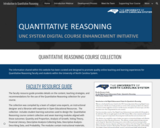
The faculty resource guide provides details on the content, teaching strategies, and recommendations for the use of the Quantitative Reasoning collection for your course.
The collection was compiled by a team of subject area experts, an instructional designer and a librarian with expertise in Open Educational Resources. The collection includes student learning outcomes used to design the Quantitative Reasoning course content collection and seven learning modules aligned with those outcomes: Quantity and Proportion, Analysis of Growth, Voting Theory, Financial Literacy, Descriptive Analysis-Collecting Data, Descriptive Analysis-Describing Data, and Probability. The modules contain instructional materials, resources, and assessments further aligned with the outcomes. In addition to the information you find here in the Implementation Guide, you will find additional explanations and suggestions within individual modules and alongside specific artifacts.

This course gives an introduction to probability and statistics, with emphasis on engineering applications. Course topics include events and their probability, the total probability and Bayes’ theorems, discrete and continuous random variables and vectors, uncertainty propagation and conditional analysis. Second-moment representation of uncertainty, random sampling, estimation of distribution parameters (method of moments, maximum likelihood, Bayesian estimation), and simple and multiple linear regression. Concepts illustrated with examples from various areas of engineering and everyday life.
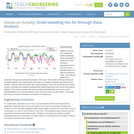
Students build on their existing air quality knowledge and a description of a data set to each develop a hypothesis around how and why air pollutants vary on a daily and seasonal basis. Then they are guided by a worksheet through an Excel-based analysis of the data. This includes entering formulas to calculate statistics and creating plots of the data. As students complete each phase of the analysis, reflection questions guide their understanding of what new information the analysis reveals. At activity end, students evaluate their original hypotheses and “put all of the pieces together.” The activity includes one carbon dioxide worksheet/data set and one ozone worksheet/data set; providing students and/or instructors with a content option. The activity also serves as a good standalone introduction to using Excel.
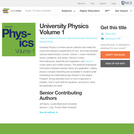
University Physics is a three-volume collection that meets the scope and sequence requirements for two- and three-semester calculus-based physics courses. Volume 1 covers mechanics, sound, oscillations, and waves. Volume 2 covers thermodynamics, electricity and magnetism, and Volume 3 covers optics and modern physics. This textbook emphasizes connections between between theory and application, making physics concepts interesting and accessible to students while maintaining the mathematical rigor inherent in the subject. Frequent, strong examples focus on how to approach a problem, how to work with the equations, and how to check and generalize the result.
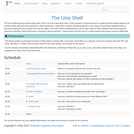
Software Carpentry lesson on how to use the shell to navigate the filesystem and write simple loops and scripts. The Unix shell has been around longer than most of its users have been alive. It has survived so long because it’s a power tool that allows people to do complex things with just a few keystrokes. More importantly, it helps them combine existing programs in new ways and automate repetitive tasks so they aren’t typing the same things over and over again. Use of the shell is fundamental to using a wide range of other powerful tools and computing resources (including “high-performance computing†supercomputers). These lessons will start you on a path towards using these resources effectively.

The course examines the causes and effects of rapid urbanization in developing countries. Using case studies from the world’s four major developing regions, including (among others) Mexico City, Buenos Aires, Managua, Singapore, Hong Kong, Guangzhou, Kabul, Beirut, Cairo, Kinshasa, Cape Town and Johannesburg, it explores the economic and political dynamics that grease the wheels of contemporary patterns of growth. In addition to examining both local and transnational forces that drive contemporary urbanization, the course focuses on key issues that emerge in rapidly growing cities of the developing world, ranging from growing income inequality and socio-economic exclusion, environmental challenges, and rising violence. Class sessions are discussion-based and focus on a critical analysis of the arguments presented in the readings.
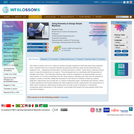
This video is meant to be a fun, hands-on session that gets students to think hard about how machines work. It teaches them the connection between the geometry that they study and the kinematics that engineers use -- explaining that kinematics is simply geometry in motion. In this lesson, geometry will be used in a way that students are not used to. Materials necessary for the hands-on activities include two options: pegboard, nails/screws and a small saw; or colored construction paper, thumbtacks and scissors. Some in-class activities for the breaks between the video segments include: exploring the role of geometry in a slider-crank mechanism; determining at which point to locate a joint or bearing in a mechanism; recognizing useful mechanisms in the students' communities that employ the same guided motion they have been studying.
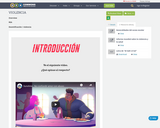
READesmitficación / violencia
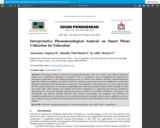
Technology continues to advance at an unprecedented pace in the 21st century; it has made an enormous impact and is undeniably ubiquitous in education. This is a qualitative study investigating the integration of smartphone applications in the teaching-learning process by teachers and students utilizing a phenomenological approach. Purposive sampling was utilized. Interviews and focus group discussions were employed to gather data through Google Sheets and Google Meet, respectively. The transcripts of these interviews, as well as reports from the focus group discussions, were analyzed using Interpretative Phenomenological Analysis (IPA). Findings revealed that senior high school teachers and students had positive perceptions of integrating and utilizing smartphone applications as a tool in the teaching and learning process in terms of accessibility, usefulness, convenience, and user-friendly and effective learning materials and resources. Interestingly, the integration and utilization of smartphone applications in each theme reveal something to be more examined, such as context, application version, lack of phone storage, and the distracting environment that dwells on the inflexibility of the curriculum and course scheme.